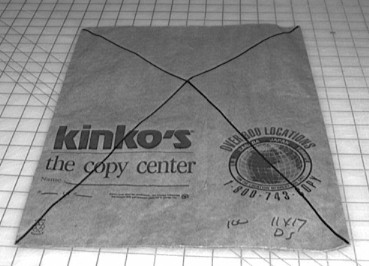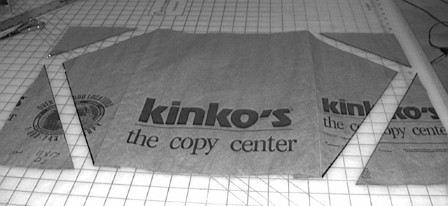
Go to a card store or a Kinko's printers and get a PAPER bag, the kind that
*does* have a gusset (the sides fold in) but *doesn't * have a "foot" (a "flat"
bottom like a grocery bag). In other words, when open, the bag cannot stand up
on its own.

Materials: 1 Kinko's (or similar) bag, some
cellophane tape or clear packing tape, glue (Elmer's white glue works, but clear
muscillage is better), at least 6 feet of 20 or 30 pound nylon string.
Tools: Scissors, yardstick (or meter stick), hole punch.
Rafter square helps.
MEASUREMENTS: These are the dimensions from the
Kinko's (a popular chain of printing shops in the USA) bag. These are presented
as an example. The actual dimensions of your bag are not as important as placing
the points 1/3 of the way down, and tying the loop in the bridle exactly in the
middle.
The Kinko's bag is 18-1/4 inches tall and 12 inches wide. After gluing the gussets shut, the top and bottom are trimmed off, the bag is then 16-1/2 inches tall. Measure down 5-1/2 inches (1/3 of the way) and 6 inches in from each side (halfway) and put a mark. Draw a line from each corner to that mark, according to the directions below.
Step 1: Glue the gussets (the folding in sides) closed. All the way, top to bottom. Let dry. (These will be the "sticks" in our sled kite.)

Step 2: Cut off the top of the bag. Be careful -
often the "front" of the bag is lower than the "back". I usually measure in to
the shorter side, and trim them even.

Step 3: Cut off the bottom of the bag. Same
procedure. I measure 16-1/2" down from the cut top to get an accurate length.
Cut off all the extra "fold" of the bottom of the bag, draw a line, and cut
*both* layers of the bag to trim off the bottom of the bag.
Step 4: Determine "front" from "back". Most
of these bags have a "seam" running up the "back" of the bag. (See picture
below). This is the side we want to work with now. (In other words, any writing
or pattern on the "good" side of the bag would be right side up.)
Step 5:
Measure one third of the way down from the "top" of the bag. Measure from side
to side and find the middle of the bag. Put a mark on the bag that is 1/3 of the
way down and in the middle (left to right). A Kinko's bag, when trimmed, is
16-1/2 inches long, so the mark will be 5-1/2 inches down from the top, and 6
inches in from each side.

Step 6: Draw a line from this mark to *each*
corner of the bag. Take the scissors and carefully cut through *one* layer only
along these lines. Try and avoid cutting the gussets.

Step 7: Open out the kite. There are now two
"points" 1/3 of the way down on each side. Cover these points with tape (to
reinforce the holes you are about to punch.) and trim to match the paper. Punch
holes on the points so that the hole has about 1/4" of clearance around the
outside.

Last Step: Take the nylon string (or any strong,
light and thin string.) The string should be 3 times the distance between the
points with the kite opened out. A kite made from a Kinko's bag is 2 feet
across, so the bridle should be 6 feet long. This is not critical, longer is
better. Tie one end of the string to one of the holes in the points, then tie
the other end to the other hole.

Match up the points of the kite (pinch them together in one hand) and find the center of the loop of string that now runs from point to point. This is important. This knot needs to be in the middle of the string, or the kite will fly to one side. After determining the center of the string, tie an Overhand Knot (the universal "package" knot. Form a loop, put the end through the loop.) . Leave a loop of string to tie to.
Go fly your kite. This is a good performer in light
winds, but will need a tail in stronger winds.
Best of luck. Kite
building is as much fun as (or more than) kite flying.
Gary Engvall's Home Page